CB Blowers
CB Blowers / Humidifiers, a Division of CB Blowers Co. is
proud to
introduce the most advanced Commercial Humidifiers in today's
market:
 Neptronic
SK300
Humidifier
Neptronic
SK300
Humidifier
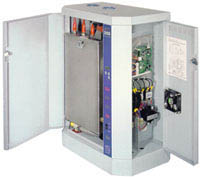 General Description:
General Description:
The SK300 are power humidifiers designed to provide dry
sterile steam for humidification.
They combine the latest microprocessor based electronic
design with carefully matched metallurgical and mechanical
technology perfected over
two decades by National Environmental Products Ltd. The design is
based
on permanent rather than replaceable containers.
The self contained SK300 steam humidifiers produce mineral
free, odourless, sterile steam without the replacement cost associated
with electrode cylinders manufactured by competitors.
SK300 Electric Humidifier has the following features:
• Capacities from 6-180lb/hr (2.7-82kg/hr) of steam
• On/Off or fully modulating with solid state relays
• BACnet interface capability
• AFEC system, mass measuring water sensor.
• Permanent stainless steel chamber with self cleaning heating elements
• Simplicity of operation and service
• Corrosion and scratch resistant aluminium housing with powder paint
finish
• Wall mounted installation
Simplicity of Operation and Service:
The SK300 humidifier consists of an automatically water
fed stainless steel container with an easily removable cover containing
heating elements and water level sensors.
Periodic servicing of the unit can be easily done in minutes. All mechanical, power and control connections are readily accessible for quick servicing.
The mechanical and electrical compartments are secured by wide hinged doors allowing comfortable inspection and access to all components.
Exceptional Reliability:
Reliability of the SK300 humidifier is one of the features that set it apart from competing humidifiers. Using the proprietary AFEC technology, the SK300 is much more forgiving to variable water conditions. Great care has been taken to select materials which have proven themselves for their exceptional performance in very harsh conditions. Such materials are elements made of super alloy, incoloy 825, teflon sleeved stainless steel level control probe, silicon tubing and baked enamel painted aluminum cabinet.Selection of electro-mechanical and electronic components has been based on many years of experience and exhaustive testing. All SK300 units pass through rigorous Q.C. inspection and full power check.
 Indicators
and Switches:
Indicators
and Switches:
ALPHANUMERIC DISPLAY Information and control center
MENU & BUTTON CONTROLS
POWER
Unit is connected to power source
CHECK
Unit indicates an abnormal condition of operation
(i.e. blocked water supply)
FILL
Water supply valve is open
STEAM
Unit is ON and there is a humidity demand
MANUAL SWITCH (3 position)
AUTO - automatic operation
OFF - unit is off
DRAIN - unit is in manual drain mode
DRAIN
unit is in drain cycle
Features:
- Permanent, easily serviceable stainless steel container
- ON-OFF or MODULATING control functions
- Interactive LCD display and microprocessor controlled self-diagnostics
- AFEC technology provides greatest energy conservation and safest operation
- Functions exceptionally well in severe, normal or D.I. water conditions
- Self-cleaning heating elements
- Unit is built from the most advanced materials such as stainless steel and teflon components and silicone hoses
Aluminum housing and the best electronic and electro-mechanical parts
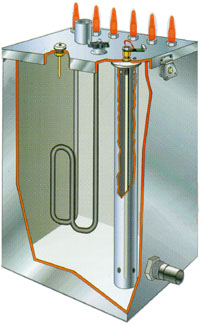
Anti-Foaming Energy Conservation System:
The AFEC technology developed by the N.E.P. engineering team offers a unique safety and energy conservation management of expensive boiling water and steam. The AFEC system is made of a mass measuring water sensor, anti-foam sensor, electronic high temperature sensor, interactive LCD display and microprocessor controller.The AFEC system is unique because:
The water sensor cannot be falsely triggered by foam formation on the top of the boiling water. This eliminates the problem of heating elements burning out in free air.
The additional foam-sensing probe, which is unique to our design, would automatically initiate a drain cycle upon foam formation. Unlike other humidifiers, the drain can be initiated only when necessary without having continuous skimming to drain expensive boiling water. This is an excellent energy conservation measure.
The SK300 is unique in having fast actin electronic safety
temperature sensors inside the steam container in very close proximity
to the heating elements. Other humidifiers use only a bimetallic
external electro-mechanical temperature switch (which is also standard
on all SK300s). Therefore, the AFEC system provides an additional
layer of protection.
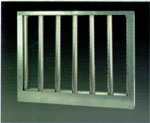 |
Multi-Steam:For the most efficient steam absorption, N.E.P. developed 3 different steam dispersion methods using the MULTI-STEAM, SAM or REGULAR distributors. |
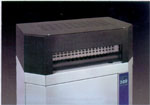 |
S.D.U. (Space Distribution Unit):Our lower profile Steam Distribution Unit is to be used where a ducted air distribution system is not available. The steam is discharged directly into the required area. S.D.U. is available in two sizes. A tangential fan delivers a quiet and efficient steam distribution. |
Dimensions:
| Model | A | B | C | D+A | SDU |
| SK302 | 597mm
23-1/2" |
470mm
18-1/2" |
292mm
11-1/2" |
737mm
29" |
SDU-1 |
| SK304 | 597mm
23-1/2" |
470mm
18-1/2" |
292mm
11-1/2" |
737mm
29" |
SDU-1 |
| SK306 | 597mm
23-1/2" |
470mm
18-1/2" |
292mm
11-1/2" |
737mm
29" |
SDU-1 |
| SK309 | 597mm
23-1/2" |
470mm
18-1/2" |
292mm
11-1/2" |
737mm
29" |
SDU-1 |
| SK311 | 597mm
23-1/2" |
470mm
18-1/2" |
292mm
11-1/2" |
737mm
29" |
SDU-1 |
| SK314 | 724mm
28-1/2" |
533mm
21-1/2" |
318mm
12-1/2" |
890mm
35" |
SDU-2 |
| SK320 | 724mm
28-1/2" |
533mm
21-1/2" |
318mm
12-1/2" |
1048mm
41-1/4" |
SDU-3 |
| SK330 | 724mm
28-1/2" |
533mm
21-1/2" |
318mm
12-1/2" |
1048mm
41-1/4" |
SDU-3 |
| SK340 | 794mm
31-1/4" |
813mm
32" |
318mm
12-1/2" |
- | - |
| SK360 | 794mm
31-1/4" |
813mm
32" |
318mm
12-1/2" |
- | - |
available on models SK302 to SK330
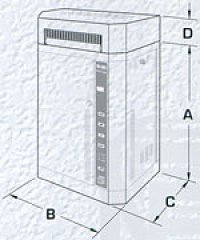
Output and Power Consumption:
| Model | Power | Capacity |
|
# of outlets |
Dia. of Outlets |
||||||
| 240/1 | 208/1 | 208/3 | 480/1 | 480/3 | 600/1 | 600/3 | |||||
| SK302 | 2 Kw | 6 lb/hr 2.73 kg/hr |
8.5 | 10 | - | 4.5 | - | 3.5 | - | 1 | 1-3/8" |
| SK304 | 4 Kw | 12 lb/hr 5.5 kg/hr |
17 | 19 | - | 8.5 | - | 7 | - | 1 | 1-3/8" |
| SK306 | 6 Kw | 18 lb/hr 8 kg/hr |
26 | 30 | - | 13 | - | 10.5 | - | 1 | 1-3/8" |
| SK309 | 9 Kw | 27 lb/hr 12 kg/hr |
- | 25 | - | 11 | - | 9 | 1 | 1-3/8" | |
| SK311 | 11 Kw | 33 lb/hr 14.5 kg/hr |
- | 31 | - | 13.2 | - | 10.5 | 1 | 1-3/8" | |
| SK314 | 13.5 Kw | 40 lb/hr 19 kg/hr |
- | 38 | - | 16.5 | - | 13.5 | 1 | 1-3/8" | |
| SK320 | 20 Kw | 60 lb/hr 28 kg/hr |
- | 57 | - | 25 | - | 20 | 1 | 1-3/8" | |
| SK330 | 30 Kw | 90 lb/hr 41 kg/hr |
- | - | - | 36 | - | 30 | 2 | 1-3/8" | |
| SK340 | 40 Kw | 120 lb/hr 56 kg/hr |
- | - | - | 50 | - | 40 | 2 | 2-1/8" | |
| SK360 | 60Kw | 180 lb/hr 82 kg/hr |
- | - | - | 72 | - | 60 | 3 | 2-1/8" | |
designate the letter D for units operating with deionized water.
* check with factory for availability.
 Neptronic
SKG3000 Gas Humidifier
Neptronic
SKG3000 Gas Humidifier

